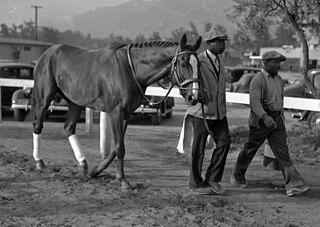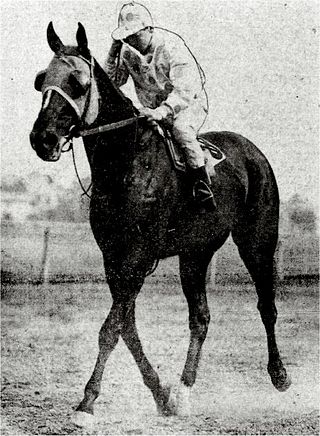
Samuel Clay Hildreth was an American Thoroughbred horse racing Hall of Fame trainer and owner.

Lexington was a United States Thoroughbred race horse who won six of his seven race starts. Perhaps his greatest fame, however, came as the most successful sire of the second half of the nineteenth century; he was the leading sire in North America 16 times, and broodmare sire of many notable racehorses.

Discovery (1931–1958) was a champion American Thoroughbred racehorse. In a racing career which lasted from 1933 to 1936 he ran sixty-three times and won twenty-seven races. One of the leading American three-year-olds of his generation in 1934, he became a dominant performer in the next two seasons. The National Museum of Racing and Hall of Fame said that he was: "...considered one of the greatest horses of the 20th century."
Edward Riley Bradley was an American steel mill laborer, gold miner, businessman and philanthropist. As well as a race track proprietor, he was the preeminent owner and breeder of Thoroughbred racehorses in the Southern United States during the first three decades of the 20th century. Testifying before a United States Senate committee in April 1934, Bradley identified himself as a "speculator, raiser of race horses and gambler". He appeared on the cover of Time magazine on May 7, 1934. In the year 2000, the Florida Department of State honored him as one of their Great Floridians.

Raise a Native was an undefeated Thoroughbred racehorse that was named 1963 champion two-year-old colt in the Turf and Sport Digest poll and was the highest rated juvenile in the Experimental Free Handicap. He sired 74 stakes winners, including Majestic Prince and Alydar. In its 1988 obituary for the horse, The New York Times called him "the most influential sire of American Thoroughbred stallions over the last 20 years".

Peter Pan (1904–1933) was an American Thoroughbred racehorse and sire, bred and raced by prominent horseman, James R. Keene. As winner of the Belmont Stakes, the Brooklyn Derby and the Brighton Handicap, he was later inducted into the National Museum of Racing and Hall of Fame. His progeny included many famous American racehorses, including several winners of the Kentucky Derby and the Preakness Stakes.
Whimsical was an American Thoroughbred racehorse. She is best known as the second filly to ever win the Preakness Stakes.

Broomstick (1901–1931) was a Thoroughbred race horse whose most important win was in the 1904 Travers Stakes. After retirement, he became one of the great sires in American racing history, leading the North American sire list in 1913, 1914 and 1915. He was inducted into the National Museum of Racing and Hall of Fame in 1956.

Hamburg (1895–1915) was an American Thoroughbred race horse. The leading American colt of his generation, Hamburg was retrospectively named the American Horse of the Year for 1898. After his racing career he went on to be a successful sire.
Serena's Song is an American Thoroughbred race horse. She won 17 graded stakes races, including 11 Grade I, in three seasons for $3,286,388 in earnings.
Purchase, an American Thoroughbred racehorse, was called "The Adonis of the Turf." Walter Vosburgh, the official handicapper for The Jockey Club as well as a turf historian for many years, wrote: "…one of the most exquisitely beautiful of racehorses…to describe Purchase would be to exhaust the superlative."
Riley was a bay colt sired by Longfellow out of Geneva. He won the 1890 Kentucky Derby for owner and trainer Edward Corrigan who shortly after would build Hawthorne Race Course which opened in Cicero, Illinois, in 1891. Ridden by future U.S. Racing Hall of Fame inductee Isaac Murphy, Riley won the mile and one-quarter Derby in 2 minutes 45 seconds, the slowest time recorded to that point due to a very muddy track. Riley was originally named Shortfellow and had a relatively long and successful career in which he had 64 starts with 30 wins, 17 places, and 4 shows.
Macbeth II was a horse who was the winner of the 1888 Kentucky Derby. He was the third gelding and one of only nine geldings to win the Kentucky Derby, with the others being Vagrant (1876), Apollo (1882), Old Rosebud (1914), Exterminator (1918), Paul Jones (1920), Clyde Van Dusen (1929), Funny Cide (2003), and Mine That Bird (2009).

His Eminence was an American Thoroughbred racehorse that was bred in Kentucky and is best known for winning the 1901 Kentucky Derby. He was a bay colt sired by the great turf-racer Falsetto out of the mare Patroness. His dam was sold to Overton H. Chenault at the 1897 Woodburn Stud dispersal sale for $75. As a yearling, he was sold to J. B. Lewman for $500[1].
Big Pebble was an American Thoroughbred Champion racehorse.

John Edward Madden was a prominent American Thoroughbred and Standardbred owner, breeder and trainer in the late nineteenth and early twentieth century. He owned Hamburg Place Stud in Lexington, Kentucky and bred five Kentucky Derby and Belmont Stakes winners.
Black Maria (1923–1932) was an American Thoroughbred racing filly who earned national Champion honors three times.
Honor Code is a Thoroughbred racehorse bred in Kentucky, USA. He was sired by A.P. Indy, son of Triple Crown winner Seattle Slew and out of mare Weekend Surprise, who was sired by another Triple Crown winner: Secretariat. His dam is Serena's Cat, a granddaughter of Hall of Famer Serena's Song. Honor Code is known for his running style, in which he falls far behind the field early and closes with a rush to the wire.

Kenneth L. "Ken" Ramsey and Sarah Kathern "Kitten" Ramsey are horse breeders and owners of Thoroughbred race horses. They have multiple graded stakes winners, three Breeders' Cup winners, and the Ramseys themselves have won multiple Eclipse Awards for outstanding owner and breeder. Ken and Sarah own Ramsey Farm, a 1,200 acre horse breeding operation in Nicholasville, Kentucky, and have raced horses at tracks throughout the United States. Many of their race horses have names incorporating the word "Kitten", Ken's nickname for Sarah Ramsey, used as the inspiration for the name of their leading stallion, Kitten's Joy, a successful racehorse in longer races on turf racetracks. When his style of racing proved unfashionable and outside breeders were reluctant to send mares to him, the Ramseys bought a herd of their own mares to breed and raced the progeny themselves, with considerable success, punctuated by Ken Ramsey personally leading most of his horses into the winner's circle after their races. To further promote the stallion, most of his offspring have "Kitten" in their names and, in some cases such as Breeders' Cup winners Bobby's Kitten and Stephanie's Kitten, the Ramseys honor friends or family members by incorporating their names as well.
The Newcastle Stable was a Thoroughbred racing partnership formed in 1903 by Life magazine publisher Andrew Miller, Blair Painter, Francis Cunningham Bishop, and trainer Thomas Welsh. Based in New York City, in January 1907 the partners leased the 350 acre Oakwood Farm near Lexington, Kentucky to be used for breeding their own horses. The partnership began operations with thirty-two broodmares and two stallions, Adam and Handspring. The France-bred Adam was a $75,000 imported son of 1899 English Triple Crown winner Flying Fox. Handspring was a multiple stakes winner sired by Hanover, a four-time Leading sire in North America. In December 1907 the partnership would acquire the entire Millstream Stud breeding farm.









